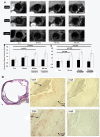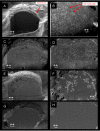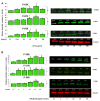Functionalization of gadolinium metallofullerenes for detecting atherosclerotic plaque lesions by cardiovascular magnetic resonance
- PMID: 23324435
- PMCID: PMC3562260
- DOI: 10.1186/1532-429X-15-7
Functionalization of gadolinium metallofullerenes for detecting atherosclerotic plaque lesions by cardiovascular magnetic resonance
Abstract
Background: The hallmark of atherosclerosis is the accumulation of plaque in vessel walls. This process is initiated when monocytic cells differentiate into macrophage foam cells under conditions with high levels of atherogenic lipoproteins. Vulnerable plaque can dislodge, enter the blood stream, and result in acute myocardial infarction and stroke. Imaging techniques such as cardiovascular magnetic resonance (CMR) provides one strategy to identify patients with plaque accumulation.
Methods: We synthesized an atherosclerotic-targeting contrast agent (ATCA) in which gadolinium (Gd)-containing endohedrals were functionalized and formulated into liposomes with CD36 ligands intercalated into the lipid bilayer. In vitro assays were used to assess the specificity of the ATCA for foam cells. The ability of ATCA to detect atherosclerotic plaque lesions in vivo was assessed using CMR.
Results: The ATCA was able to detect scavenger receptor (CD36)-expressing foam cells in vitro and were specifically internalized via the CD36 receptor as determined by focused ion beam/scanning electron microscopy (FIB-SEM) and Western blotting analysis of CD36 receptor-specific signaling pathways. The ATCA exhibited time-dependent accumulation in atherosclerotic plaque lesions of ApoE -/- mice as determined using CMR. No ATCA accumulation was observed in vessels of wild type (C57/b6) controls. Non-targeted control compounds, without the plaque-targeting moieties, were not taken up by foam cells in vitro and did not bind plaque in vivo. Importantly, the ATCA injection was well tolerated, did not demonstrate toxicity in vitro or in vivo, and no accumulation was observed in the major organs.
Conclusions: The ATCA is specifically internalized by CD36 receptors on atherosclerotic plaque providing enhanced visualization of lesions under physiological conditions. These ATCA may provide new tools for physicians to non-invasively detect atherosclerotic disease.
Figures





Similar articles
-
Vav Guanine nucleotide exchange factors regulate atherosclerotic lesion development in mice.Arterioscler Thromb Vasc Biol. 2013 Sep;33(9):2053-7. doi: 10.1161/ATVBAHA.113.301414. Epub 2013 Jul 3. Arterioscler Thromb Vasc Biol. 2013. PMID: 23825362 Free PMC article.
-
A leukocyte-mimetic magnetic resonance imaging contrast agent homes rapidly to activated endothelium and tracks with atherosclerotic lesion macrophage content.Arterioscler Thromb Vasc Biol. 2012 Jun;32(6):1427-35. doi: 10.1161/ATVBAHA.111.241844. Epub 2012 Apr 12. Arterioscler Thromb Vasc Biol. 2012. PMID: 22499989 Free PMC article.
-
Downregulations of CD36 and Calpain-1, Inflammation, and Atherosclerosis by Simvastatin in Apolipoprotein E Knockout Mice.J Vasc Res. 2017;54(3):123-130. doi: 10.1159/000464288. Epub 2017 Apr 28. J Vasc Res. 2017. PMID: 28448973
-
CD36, a scavenger receptor implicated in atherosclerosis.Exp Mol Med. 2014 Jun 6;46(6):e99. doi: 10.1038/emm.2014.38. Exp Mol Med. 2014. PMID: 24903227 Free PMC article. Review.
-
Mechanisms of cell signaling by the scavenger receptor CD36: implications in atherosclerosis and thrombosis.Trans Am Clin Climatol Assoc. 2010;121:206-20. Trans Am Clin Climatol Assoc. 2010. PMID: 20697562 Free PMC article. Review.
Cited by
-
Promising therapeutic effect of thapsigargin nanoparticles on chronic kidney disease through the activation of Nrf2 and FoxO1.Aging (Albany NY). 2019 Nov 12;11(21):9875-9892. doi: 10.18632/aging.102437. Epub 2019 Nov 12. Aging (Albany NY). 2019. PMID: 31714893 Free PMC article.
-
Toxicity Mechanism of Low Doses of NaGdF₄:Yb3+,Er3+ Upconverting Nanoparticles in Activated Macrophage Cell Lines.Biomolecules. 2019 Jan 3;9(1):14. doi: 10.3390/biom9010014. Biomolecules. 2019. PMID: 30609856 Free PMC article.
-
Use of trimetasphere metallofullerene MRI contrast agent for the non-invasive longitudinal tracking of stem cells in the lung.Methods. 2016 Apr 15;99:99-111. doi: 10.1016/j.ymeth.2015.11.004. Epub 2015 Nov 10. Methods. 2016. PMID: 26546729 Free PMC article.
-
Toxicological status of nanoparticles: What we know and what we don't know.Chem Biol Interact. 2018 Nov 1;295:1-12. doi: 10.1016/j.cbi.2018.07.015. Epub 2018 Jul 23. Chem Biol Interact. 2018. PMID: 30048623 Free PMC article. Review.
-
Review of Journal of Cardiovascular Magnetic Resonance 2013.J Cardiovasc Magn Reson. 2014 Dec 5;16:100. doi: 10.1186/s12968-014-0100-2. J Cardiovasc Magn Reson. 2014. PMID: 25475898 Free PMC article. Review.
References
Publication types
MeSH terms
Substances
Grants and funding
LinkOut - more resources
Full Text Sources
Other Literature Sources
Medical
Miscellaneous

